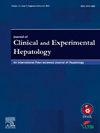法恩类 X 受体激动剂治疗代谢功能障碍相关性脂肪肝的疗效、安全性和耐受性:系统综述与元分析
IF 3.2
Q2 GASTROENTEROLOGY & HEPATOLOGY
Journal of Clinical and Experimental Hepatology
Pub Date : 2025-03-30
DOI:10.1016/j.jceh.2025.102563
引用次数: 0
摘要
背景/目的代谢功能障碍相关脂肪变性肝病(MASLD)是慢性肝病的主要原因。法内甾体X受体(FXR)激动剂正在成为治疗纤维化、脂肪变性和代谢功能障碍的有前景的疗法。然而,其有效性和安全性仍不清楚。方法系统检索PubMed、Embase和Cochrane数据库,确定比较FXR激动剂和安慰剂治疗MASLD患者的随机对照试验(rct)。主要结果包括肝纤维化改善,但不加重脂肪性肝炎,肝化学和脂质谱的变化,以及肝脂肪含量(LFC)。评估的安全性结果包括副作用和停药率。异质性评价采用I²统计量,随机效应模型应用于合并分析。结果纳入10项随机对照试验,共3779例患者,其中2527例(67%)随机接受FXR激动剂治疗。FXR激动剂可显著改善≥1期纤维化(RR, 1.52;95% ci: [1.23, 1.88];P & lt;0.0001), LFC降低(平均差值:−4.9%;95% ci:[−8.26,−1.55];P & lt;0.001)。LFC降低≥30%的患者比例更高(42.8% vs. 18.4%;RR 2.42;95% ci: [1.69, 3.46];P & lt;0.00001)。丙氨酸转氨酶和谷氨酰转移酶水平显著降低,而碱性磷酸酶水平升高。FXR激动剂与高密度脂蛋白(HDL)胆固醇水平的轻微降低和瘙痒的较高发生率相关(37.8% vs. 18.7%;RR 2.67;95% ci: [1.63, 4.38];P & lt;0.00001),导致更高的治疗中断率。结论fxr激动剂有改善MASLD患者纤维化和脂肪变性的潜力。然而,安全问题仍然存在。需要进一步的研究来确定这些药物的长期疗效和耐受性。本文章由计算机程序翻译,如有差异,请以英文原文为准。

Efficacy, Safety, and Tolerability of Farnesoid X Receptor Agonists in the Treatment of Metabolic Dysfunction-associated Steatotic Liver Disease: A Systematic Review and Meta-analysis
Background/Aims
Metabolic dysfunction-associated steatotic liver disease (MASLD) is a leading cause of chronic liver disease. Farnesoid X receptor (FXR) agonists are emerging as promising therapies for fibrosis, steatosis, and metabolic dysfunctions. However, its efficacy and safety remain unclear.
Methods
A systematic search of PubMed, Embase, and Cochrane databases identified randomized controlled trials (RCTs) comparing FXR agonists with placebo in patients with MASLD. The main outcomes included improvement in fibrosis without worsening steatohepatitis, changes in liver chemistry and lipid profiles, and liver fat content (LFC). The safety outcomes assessed included side effects and treatment discontinuation rates. Heterogeneity was evaluated using I² statistics, with a random-effects model applied to the pooled analyses.
Results
Ten RCTs involving 3,779 patients were included, of which 2,527 (67%) were randomized to receive FXR agonists. FXR agonists significantly improved fibrosis by ≥ 1 stage (RR, 1.52; 95% CI: [1.23, 1.88]; P < 0.0001) and reduced LFC (mean difference: −4.9%; 95% CI: [−8.26, −1.55]; P < 0.001). A higher proportion of patients achieved a ≥30% reduction in LFC (42.8% vs. 18.4%; RR, 2.42; 95% CI: [1.69, 3.46]; P < 0.00001). Significant reductions in alanine aminotransferase and gamma glutamyltransferase levels were observed, whereas alkaline phosphatase levels were increased. FXR agonists were associated with a slight reduction in High-Density Lipoprotein (HDL) cholesterol levels and a higher incidence of pruritus (37.8% vs. 18.7%; RR, 2.67; 95% CI: [1.63, 4.38]; P < 0.00001), leading to higher treatment discontinuation rates.
Conclusion
FXR agonists have the potential to improve fibrosis and steatosis in MASLD patients. However, safety concerns still remain. Further research is required to determine the long-term efficacy and tolerability of these drugs.
求助全文
通过发布文献求助,成功后即可免费获取论文全文。
去求助
来源期刊

Journal of Clinical and Experimental Hepatology
GASTROENTEROLOGY & HEPATOLOGY-
CiteScore
4.90
自引率
16.70%
发文量
537
审稿时长
64 days
 求助内容:
求助内容: 应助结果提醒方式:
应助结果提醒方式:


